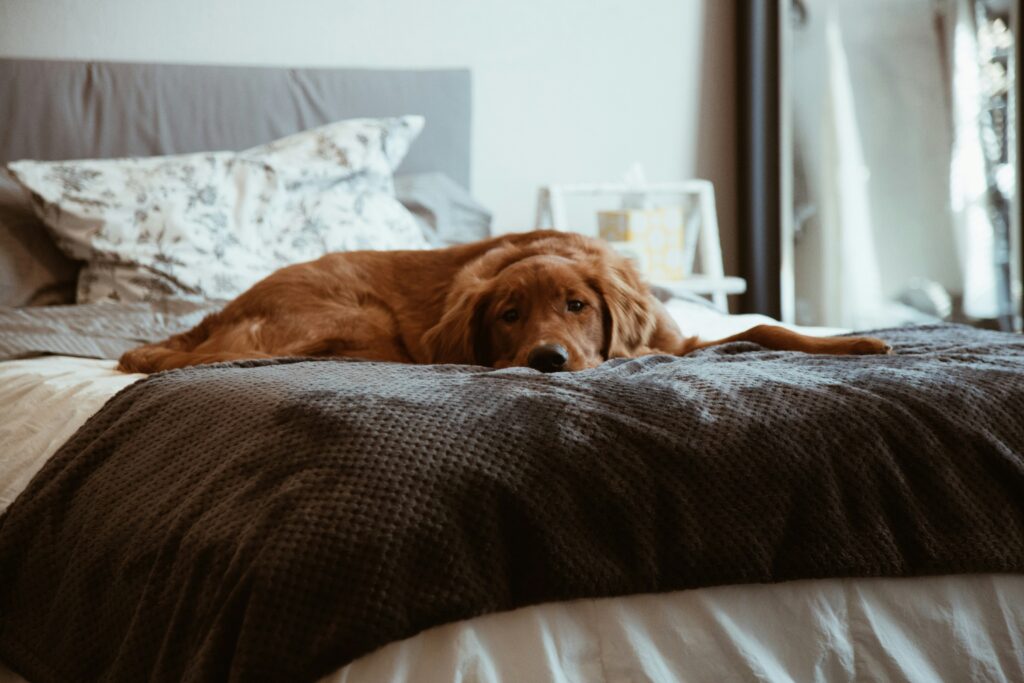Should You Let A Dog Sleep In Your Bed?
Should You Let a Dog Sleep in Your Bed? A Detailed Look at Pros, Cons, and Best Practices
For millions of dog owners, sharing a bed with their furry friend is a nightly routine. It’s comforting, cosy, and deepens the bond between human and pet. But is it the right decision for everyone?
Whether you’re considering letting your dog onto the bed or wondering if you should stop the habit, this guide takes an in-depth look at the physical, emotional, and behavioural aspects of co-sleeping with your dog. Personally, we don’t mind the dogs sleeping in the bed, although we know that this issue is a topic that has been debated time and time again, so we thought we’d put some information out there to better help you make your choice.
The Popularity of Co-Sleeping with Dogs
Studies show that over 40% of dog owners allow their dogs to sleep in their beds. This figure rises among single adults and those who treat their dogs as part of the family. The practice has even prompted terms like “fur baby” and “co-sleeping pack.”
One thing is for sure, owners with smaller dogs are more likely to let their dogs sleep in the bed, owners with larger dogs, not so much. But while it’s common, it’s not one-size-fits-all. So, what are the pros and cons?
Benefits of Letting Your Dog Sleep in Your Bed
Emotional Comfort and Bonding
Dogs are natural pack animals. Sleeping close reinforces their sense of security and strengthens the human-animal bond.
- Reduces anxiety (in both pets and owners)
- Promotes feelings of companionship and safety
- Especially comforting for people who live alone or suffer from depression
Better Sleep for Some People
For certain individuals, the sound of a dog breathing or the warmth of their body can help induce sleep.
- Mimics a “weighted blanket” effect for anxious sleepers
- May reduce night terrors or feelings of loneliness
- Your dog also provides warmth, so in the winter, this is an added bonus.
Your Dog Feels Included
Allowing your dog to sleep in your bed can reinforce trust and security, especially in rescue dogs or those with attachment anxiety.
Drawbacks of Sleeping With Your Dog
Interrupted Sleep
Dogs move, scratch, snore, and sometimes bark in their sleep. Some owners find their quality of rest declines. It’s important to remember that dogs do not stay in one place like humans and are prone to move around a lot, which can include jumping on and off the bed.
- May cause fragmented or lighter sleep
- Dogs may wake early, disrupting your REM cycles
- Light sleepers may suffer from every toss and turn
Allergies and Hygiene
Even the cleanest dogs bring in allergens, dirt, and dander. This is why if you let your dog sleep in the bed, you should change your bedding every two weeks or depending on your dog, possibly every week. Which doesn’t help with the amount of washing you have to do.
- Risk of worsening allergies or asthma
- Dogs can carry ticks or fleas indoors
- Dirt from paws and shedding can soil sheets
Behavioural Issues
Some dogs may develop territorial behaviour over the bed or become overly dependent.
- Increased risk of resource guarding
- May resist being moved or corrected
- Can complicate training, especially in dominant or anxious breeds
It’s important to keep in mind that you know your dog, and can make the judgment on whether you think letting them sleep in the bed is a good idea or not. You may also find that your dog is more comfortable in their dog bed, rather than your bed, so don’t try and pressure them, or this can cause issues.
Health Risks
While rare, some zoonotic (pet-to-human) diseases or parasites can be transferred through close contact. Also, dogs with medical conditions (e.g., incontinence, infections) may not be ideal bedmates.
If you are going to let your dog or dogs sleep in your bed, it’s also important to use flea preventatives and make sure that they aren’t covering your bed in fleas, as that’s not good for the dog or their owner.

When It’s Best to Say No
- If you have severe allergies or asthma
- If your dog has aggression or dominance issues
- If you’re a light sleeper and need quality rest
- If your dog is undergoing house training
- If your dog has health problems that require separate space (incontinence, wounds, etc.)
Best Practices If You Decide to Share Your Bed
If you choose to let your dog sleep in your bed, here’s how to make it a healthy habit for both of you:
Keep Bedding Clean
- Wash sheets frequently. This goes for all your bedding not just your sheets and we would advise having a mattress protector and pillow protectors as well.
- Use washable blankets or a designated dog blanket on top of your bedding.
Maintain Parasite Control
- Ensure your dog is up to date on flea, tick, and worm treatments.
Stick to Boundaries
- Teach commands like “off” or “down” so you stay in control.
- Don’t allow bed guarding or growling.
- If your dog is crowding your space, consider a crate or separate bed beside you.
Keep Dogs Off When Sick or Dirty
- After vet visits, beach days, or muddy walks, keep them on their own bedding.
This can’t be easy, especially if you normally let them sleep in the bed. Although most of the time, when a dog is sick, it cannot be passed onto humans, there is still a risk. If your dog is dirty, introduce them to the bath and shower, make it into a routine and not something to be feared.
Watch for Signs of Behavioural Changes
- If your dog becomes clingy, aggressive, or anxious when separated, it may be time to reassess the sleeping arrangement.
This can happen more in a couple’s dynamic, the dog must have bonding time with both of the owners and not just one of them. You can do this by taking them on walks with just one person and switching up who gives the dog their food, so it’s not the same person.
Alternatives to Sharing the Bed
You can still keep your dog close at night without sharing a pillow:
- Dog bed next to your bed – Offers proximity without sharing space.
- Crate in the bedroom – Helps with training and gives dogs a den-like feeling.
- Pet stairs or ramp – If you allow bed access but want to protect joints in older or smaller dogs.
Although these ideas are great in theory, they won’t work for all dogs. You are the one person who knows your dog best so try ways that you think might work best.
Conclusion: Should You Let a Dog Sleep in Your Bed?
There’s no universal answer. If it improves your well-being, strengthens your bond, and doesn’t interfere with sleep or behaviour, co-sleeping can be a wonderful experience. But if allergies, training issues, or poor sleep quality become concerns, it’s okay to set boundaries.
The key is to do what works best for both you and your dog—because a well-rested, happy human makes for a better pet parent.
Personally, we let our dogs sleep in our beds. There are rules in place and as they are small we’ve had no issues. Max will move if he is asked to and a lot of the time he takes himself off to his own bed after a couple of hours as he doesn’t like us moving around. Do what works best for you and your dog.

